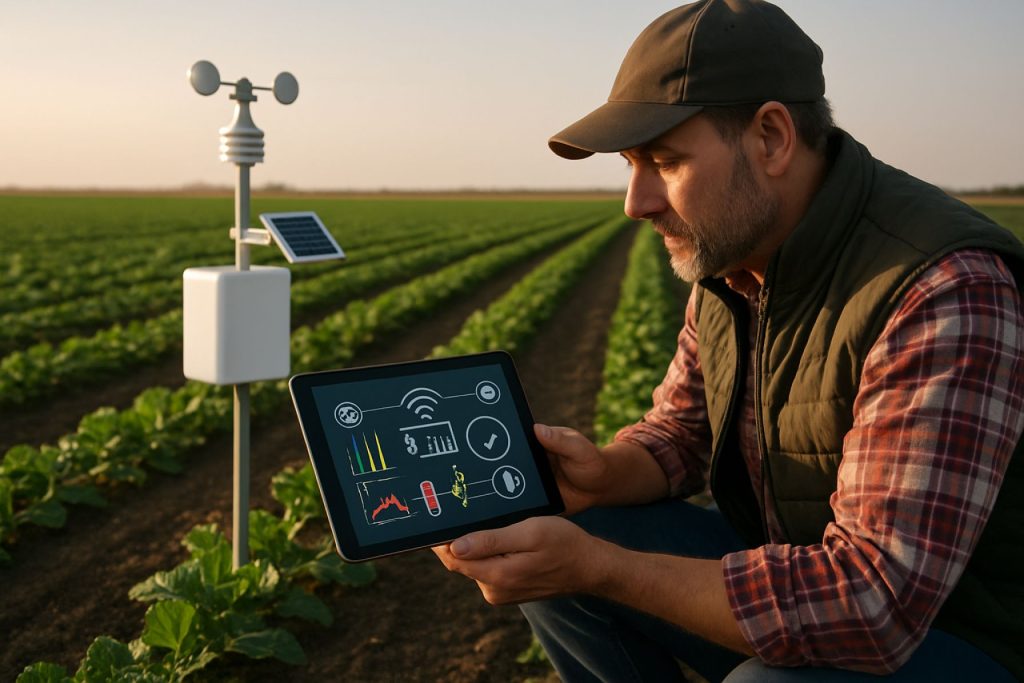
How the Zigbee Protocol Powers Smart Agriculture: Exploring Its Role in Efficient Farm Management and Data-Driven Cultivation
- Introduction to Zigbee Protocol in Smart Agriculture
- Key Features of Zigbee for Agricultural Applications
- Wireless Sensor Networks: Zigbee’s Role in Field Monitoring
- Energy Efficiency and Scalability in Farm Deployments
- Case Studies: Real-World Implementations of Zigbee in Agriculture
- Integration with IoT Platforms and Data Analytics
- Challenges and Limitations of Zigbee in Agricultural Environments
- Future Prospects: Evolving Standards and Emerging Use Cases
- Conclusion: The Impact of Zigbee Protocol on Modern Farming
- Sources & References
Introduction to Zigbee Protocol in Smart Agriculture
The Zigbee protocol is a wireless communication standard designed for low-power, low-data-rate applications, making it particularly suitable for the demands of smart agriculture. In the context of agriculture, Zigbee enables the creation of robust wireless sensor networks (WSNs) that facilitate real-time monitoring and automation of various farming processes. These networks can interconnect a wide array of sensors and actuators distributed across fields, greenhouses, or livestock facilities, providing critical data on soil moisture, temperature, humidity, and crop health. The protocol’s mesh networking capability ensures reliable data transmission even in challenging outdoor environments, as information can hop between multiple nodes to reach its destination, thereby extending coverage and resilience against node failures.
Smart agriculture leverages Zigbee’s energy efficiency and scalability to support precision farming practices, which aim to optimize resource use and increase yields while minimizing environmental impact. The protocol’s interoperability with other standards and its support for secure, encrypted communication further enhance its appeal for agricultural deployments. By enabling seamless integration of sensors, controllers, and gateways, Zigbee-based systems empower farmers to make data-driven decisions, automate irrigation, monitor livestock, and detect anomalies early, ultimately improving productivity and sustainability. As the agricultural sector increasingly adopts digital technologies, Zigbee stands out as a foundational enabler of the Internet of Things (IoT) in rural and remote settings, where power and connectivity constraints are significant considerations Connectivity Standards Alliance National Institute of Standards and Technology.
Key Features of Zigbee for Agricultural Applications
Zigbee protocol offers several key features that make it particularly suitable for smart agriculture applications. One of its primary advantages is low power consumption, which allows battery-powered sensors and devices to operate for extended periods—often several years—without frequent maintenance. This is crucial in agricultural environments where devices may be deployed across vast and remote fields. Zigbee’s mesh networking capability further enhances its suitability, enabling devices to relay data through neighboring nodes. This not only extends the communication range but also increases network reliability, as data can find alternative paths if a node fails or is obstructed.
Another significant feature is Zigbee’s scalability. The protocol supports large networks, accommodating up to thousands of nodes, which is essential for monitoring diverse parameters such as soil moisture, temperature, humidity, and crop health across expansive agricultural areas. Zigbee also operates in the unlicensed ISM bands (2.4 GHz, 868 MHz, and 915 MHz), reducing operational costs and regulatory hurdles for farmers and agribusinesses.
Security is a further strength, with Zigbee providing robust encryption and authentication mechanisms to protect sensitive agricultural data from unauthorized access. Additionally, Zigbee devices are known for their interoperability, allowing integration with a wide range of sensors and actuators from different manufacturers, which is vital for building flexible and future-proof smart agriculture systems. These features collectively position Zigbee as a leading protocol for enabling efficient, reliable, and scalable wireless sensor networks in modern agricultural practices (Connectivity Standards Alliance; Texas Instruments).
Wireless Sensor Networks: Zigbee’s Role in Field Monitoring
Wireless Sensor Networks (WSNs) are foundational to the advancement of smart agriculture, enabling real-time monitoring and management of field conditions. Within this context, the Zigbee protocol plays a pivotal role due to its low power consumption, mesh networking capabilities, and cost-effectiveness. Zigbee-based WSNs facilitate the deployment of numerous sensor nodes across large agricultural fields, where each node can monitor parameters such as soil moisture, temperature, humidity, and light intensity. The mesh topology supported by Zigbee ensures robust communication, as data can be relayed through multiple nodes, thereby extending coverage and enhancing reliability even in challenging terrains.
One of Zigbee’s key advantages in field monitoring is its energy efficiency, which allows sensor nodes to operate on battery power for extended periods—often several years—without frequent maintenance. This is particularly valuable in remote or hard-to-access agricultural areas. Additionally, Zigbee’s support for self-healing networks means that if a node fails or is obstructed, data can be rerouted through alternative paths, minimizing data loss and ensuring continuous monitoring.
The protocol’s interoperability and scalability further enable integration with other agricultural management systems, supporting data-driven decision-making for irrigation, fertilization, and pest control. As a result, Zigbee-based WSNs contribute significantly to optimizing resource use, improving crop yields, and reducing environmental impact in smart agriculture settings. For more technical details on Zigbee’s application in WSNs, refer to the Connectivity Standards Alliance and the IEEE.
Energy Efficiency and Scalability in Farm Deployments
Energy efficiency and scalability are critical considerations in the deployment of wireless sensor networks for smart agriculture, where large-scale, distributed monitoring is required across expansive and often remote farmland. The Zigbee protocol is particularly well-suited to address these challenges due to its low-power design and mesh networking capabilities. Zigbee devices operate in a low-duty cycle mode, allowing sensors and actuators to remain in sleep mode for extended periods and only activate when necessary, significantly reducing energy consumption and extending battery life—an essential feature for devices deployed in hard-to-reach agricultural environments (Zigbee Alliance).
Scalability is another key advantage of Zigbee in smart agriculture. The protocol supports mesh networking, enabling each device to relay data for others, thus expanding the network’s coverage without requiring direct communication with a central hub. This self-healing mesh topology ensures robust communication even if individual nodes fail or are obstructed, which is common in dynamic farm settings. Zigbee networks can support hundreds of nodes, making it feasible to monitor soil moisture, temperature, humidity, and crop health across large fields (Texas Instruments). Furthermore, the protocol’s ability to integrate new devices seamlessly allows for incremental scaling as farm operations grow or as new monitoring requirements emerge.
By combining low energy consumption with flexible, scalable networking, Zigbee enables cost-effective, reliable, and sustainable smart agriculture solutions, supporting precision farming and resource optimization on a large scale.
Case Studies: Real-World Implementations of Zigbee in Agriculture
Several real-world case studies highlight the practical benefits and challenges of deploying Zigbee protocol in smart agriculture. For instance, in India, a precision agriculture project utilized Zigbee-based wireless sensor networks (WSNs) to monitor soil moisture, temperature, and humidity across large paddy fields. The system enabled automated irrigation, reducing water usage by up to 30% and increasing crop yields, as reported by the Indian Institute of Technology Kharagpur. The low power consumption and mesh networking capabilities of Zigbee allowed sensors to operate for months without battery replacement, even in remote areas.
In Spain, a vineyard management system implemented by the Spanish National Research Council (CSIC) leveraged Zigbee nodes to collect microclimate data and transmit it to a central gateway. This real-time data supported disease prediction models and optimized pesticide application, resulting in a 20% reduction in chemical use and improved grape quality. The robust communication in the presence of physical obstacles, such as dense foliage, demonstrated Zigbee’s suitability for complex agricultural environments.
Another notable example is the deployment of Zigbee-enabled greenhouse automation in the Netherlands, where the Wageningen University & Research developed a system for controlling temperature, humidity, and lighting. The system’s scalability allowed integration of hundreds of sensors and actuators, providing granular environmental control and energy savings of up to 15%. These case studies collectively underscore Zigbee’s effectiveness in enhancing resource efficiency, sustainability, and productivity in diverse agricultural settings.
Integration with IoT Platforms and Data Analytics
The integration of the Zigbee protocol with IoT platforms and data analytics is pivotal in advancing smart agriculture. Zigbee’s low-power, mesh networking capabilities enable seamless connectivity among a wide array of field sensors, actuators, and gateways. These devices collect real-time data on soil moisture, temperature, humidity, and crop health, which is then transmitted via Zigbee-enabled networks to centralized IoT platforms for aggregation and analysis. Such platforms, like Microsoft Azure IoT Hub and Google Cloud IoT, provide robust infrastructure for device management, data storage, and secure communication.
Once data is centralized, advanced analytics and machine learning algorithms can be applied to extract actionable insights. For example, predictive models can forecast irrigation needs or detect early signs of pest infestations, enabling farmers to make data-driven decisions that optimize resource use and crop yield. The interoperability of Zigbee with standard IoT protocols (such as MQTT and HTTP) further facilitates integration with cloud-based analytics services and dashboards, ensuring that stakeholders can access real-time visualizations and alerts from any location. Additionally, the use of open-source platforms like Eclipse IoT enhances flexibility and scalability, allowing for the customization of analytics workflows tailored to specific agricultural requirements.
In summary, the synergy between Zigbee networks, IoT platforms, and data analytics not only streamlines farm operations but also supports sustainable agriculture by enabling precise monitoring and efficient resource management.
Challenges and Limitations of Zigbee in Agricultural Environments
While the Zigbee protocol offers significant advantages for smart agriculture—such as low power consumption, mesh networking, and cost-effectiveness—it also faces several challenges and limitations in agricultural environments. One primary concern is the limited communication range of Zigbee devices, typically up to 100 meters in open space, which can be further reduced by obstacles like dense vegetation, trees, or agricultural infrastructure. This necessitates the deployment of numerous relay nodes to maintain network connectivity across large fields, increasing installation and maintenance complexity.
Another challenge is the susceptibility of Zigbee networks to interference from other wireless technologies operating in the 2.4 GHz ISM band, such as Wi-Fi and Bluetooth. Such interference can degrade network performance, leading to data loss or increased latency, which is critical in real-time monitoring and control applications. Additionally, environmental factors such as humidity, rain, and temperature fluctuations can impact signal strength and reliability, posing further difficulties for consistent data transmission in outdoor agricultural settings.
Scalability is also a concern, as Zigbee networks are typically limited to 65,000 nodes, but practical deployments often face constraints due to network congestion and routing inefficiencies in large-scale farms. Security is another limitation; while Zigbee provides basic encryption and authentication, it may not be robust enough to prevent sophisticated cyber-attacks targeting agricultural data and infrastructure. Finally, the integration of Zigbee with other IoT platforms and legacy systems can be challenging due to interoperability issues and the lack of standardized protocols across different vendors and technologies (Zigbee Alliance; National Institute of Standards and Technology).
Future Prospects: Evolving Standards and Emerging Use Cases
The future of Zigbee protocol in smart agriculture is shaped by evolving standards and the emergence of innovative use cases that address the sector’s growing demands for efficiency, sustainability, and scalability. As the Internet of Things (IoT) ecosystem matures, Zigbee is expected to integrate more seamlessly with other wireless protocols and cloud-based platforms, enabling unified management of diverse agricultural devices and sensors. The ongoing development of Zigbee 3.0, which consolidates previous Zigbee profiles into a single, interoperable standard, is a significant step toward simplifying device compatibility and enhancing network robustness in large-scale agricultural deployments (Connectivity Standards Alliance).
Emerging use cases for Zigbee in smart agriculture include precision irrigation systems that dynamically adjust water delivery based on real-time soil moisture data, and automated pest monitoring networks that trigger targeted interventions only when necessary. The protocol’s low power consumption and mesh networking capabilities make it ideal for remote, expansive farmland where reliable connectivity is essential but infrastructure is limited. Additionally, integration with artificial intelligence and machine learning platforms is anticipated to enable predictive analytics for crop health, yield forecasting, and resource optimization (Food and Agriculture Organization of the United Nations).
Looking ahead, the adoption of open standards and interoperability frameworks will further expand Zigbee’s role in smart agriculture, supporting the transition toward fully autonomous farms and data-driven decision-making. As regulatory and market pressures push for greater transparency and traceability, Zigbee-enabled solutions are poised to play a pivotal role in the digital transformation of agriculture.
Conclusion: The Impact of Zigbee Protocol on Modern Farming
The integration of the Zigbee protocol into smart agriculture has significantly transformed modern farming practices by enabling efficient, scalable, and cost-effective wireless sensor networks. Zigbee’s low power consumption and robust mesh networking capabilities allow for the deployment of extensive sensor arrays across large agricultural fields, facilitating real-time monitoring of soil moisture, temperature, humidity, and crop health. This granular data collection supports precision agriculture, enabling farmers to optimize irrigation, fertilization, and pest control, thereby increasing yields and resource efficiency.
Moreover, Zigbee’s interoperability and adherence to open standards foster compatibility among devices from different manufacturers, reducing vendor lock-in and promoting innovation. The protocol’s self-healing mesh topology ensures reliable data transmission even in challenging rural environments, where obstacles and long distances can disrupt communication. As a result, farmers benefit from improved decision-making, reduced operational costs, and enhanced sustainability.
The adoption of Zigbee in smart agriculture also aligns with broader trends in digital transformation and the Internet of Things (IoT), supporting the development of automated systems such as remote irrigation control and livestock monitoring. These advancements contribute to labor savings and improved farm management, addressing the challenges of labor shortages and climate variability.
In conclusion, the Zigbee protocol has emerged as a cornerstone technology in the evolution of smart agriculture, driving increased productivity, sustainability, and resilience in modern farming systems. Its continued development and integration with emerging technologies are expected to further amplify its impact on the agricultural sector in the coming years (Zigbee Alliance; Food and Agriculture Organization of the United Nations).
Sources & References
- Connectivity Standards Alliance
- National Institute of Standards and Technology
- Texas Instruments
- IEEE
- Zigbee Alliance
- Spanish National Research Council (CSIC)
- Wageningen University & Research
- Google Cloud IoT
- Eclipse IoT
- Food and Agriculture Organization of the United Nations



